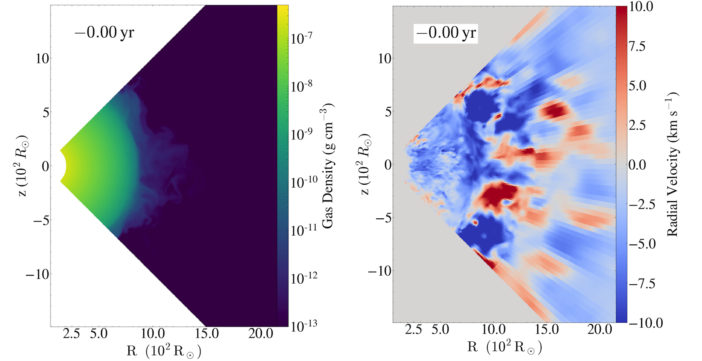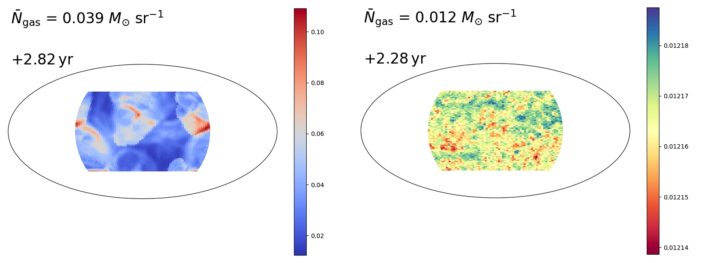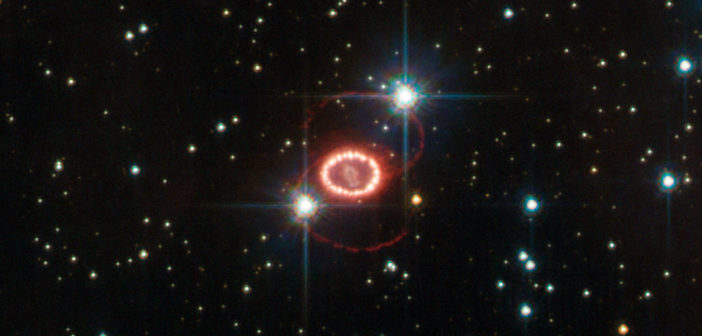Editor’s Note: Astrobites is a graduate-student-run organization that digests astrophysical literature for undergraduate students. As part of the partnership between the AAS and astrobites, we occasionally repost astrobites content here at AAS Nova. We hope you enjoy this post from astrobites; the original can be viewed at astrobites.org.
Title: 3D Hydrodynamics of Pre-supernova Outbursts in Convective Red Supergiant Envelopes
Authors: Benny T.-H. Tsang, Daniel Kasen, and Lars Bildsten
First Author’s Institution: University of California, Berkeley
Status: Published in ApJ
All right, I know what you’re thinking: “What do my digestive problems (for the hopefully very few of you) have to do with a star’s last, quite spectacular, goodbye?” Unlike most humans, stars don’t possess working intestines, and their outbursts — supernovae — are far more impressive than anything we can manage. There are many different kinds of supernovae, but they are broadly split into two categories: Type I and Type II. We typically see no emission lines of hydrogen in the spectra of Type I supernovae (here’s an example of why), while the spectra of Type II supernovae do contain hydrogen lines. We will talk about this latter type in today’s bite.
Red Supergiant Burps and Interacting Supernovae
Before red supergiants go supernova, they are prone to breathtaking belches called pre-supernova outbursts. These outbursts push huge amounts of gas from the star out into the so-called circumstellar medium — the material in the star’s direct neighborhood. If this neighborhood is filled with enough gas when a star dies, the expanding supernova will push against and interact with this material. This interplay between the material around the star and the supernova can actually be observed from Earth, giving rise to what is known as a Type IIn or interacting supernova.
How visible this interaction is depends mostly on how much material is in the stellar neighborhood. This depends again on how much gas the star decides to throw out, and also on how these pre-supernova outbursts (or burps) are actually formed. The authors of today’s article show that this has a lot to do with convection in the red supergiant.
Red Supergiant Boiling Pot
Simulating these red supergiant outbursts shortly before they go supernova is not new, so we already know the causes of these pre-supernova outbursts:
- Increasingly unstable nuclear fusion in the core of the star causes powerful gravity waves (not to be confused with gravitational waves)
- Large-scale convection in the red supergiant carries around material in the star, which can destabilize the nuclear fusion in the core, giving a very variable energy output
- Pair instability can cause the core’s energy output to go through cycles of drops and spikes
- A binary companion star can disturb the red supergiant enough to cause the star to temporarily become unstable
The bottom line is that some process releases a large amount of extra energy inside the star, which, depending on how the star reacts to this energy release, can lead to different outbursts of gas. Until now, the simulations of these outbursts have usually been spherically symmetric, meaning that the simulation of the outburst looks exactly the same from any direction. You can also see this as a simulation along a single line of sight from the outside of the star inwards (i.e., one-dimensional).
The problem with this approach is that you cannot simulate convection this way. To deal with convection, the authors of today’s article took the brute-force approach and did a fully 3D simulation. They simulated the region of the star outside the nuclear core (called the envelope) and started with a large energy release at the innermost part of their simulation. The authors considered different styles of energy release in the envelope. These included:
- A large, sudden energy release, comparable to the energy needed to keep the star together by gravity. This can cause a mass ejection, quite like the Sun but on much larger scales.
- A slow release of energy, which causes a much steadier stream of mass flowing away from the star instead of an explosive loss of mass.
- Varying direction of energy release, which influences how (and where to) the pre-supernova outburst will occur.
A snapshot of the authors’ simulation is shown in Figure 1. Here, we see both the envelope density on the left and the velocity of the envelope gas in the radial direction on the right. In the velocity graph, we can see zones both moving away from the star and falling back towards the core. These are the same as convection cells we can find in daily life — like in a pot of boiling water.

Figure 1: Left: Density slice of the star’s outer layers, with radius (R) vs. the distance from the core to the pole (z). Right: Velocity in the radial direction (away from the core) slice with the same axes as on the left. [Tsang et al. 2022]
We can also see this in Figure 2: the simulation in the left panel, which included the convection, resulted in much more mass loss than the simulation in the right panel, which did not. These channels of low density appear where most of the mass escapes in the convection simulation.

Figure 2: Two images of the star’s surface in Mollweide projection, showing how much mass has escaped. On the left is a model with convection, where the colors indicate the amount of mass lost per direction (or, specifically, solid angle). On the right is a simulation without convection. [Tsang et al. 2022]
Original astrobite edited by Sasha Warren.
About the author, Roel Lefever:
Roel is a first-year PhD student at Heidelberg University, studying astrophysics. He works on massive stars and simulates their atmospheres/outflows. In his spare time, he likes to hike/bike in nature, play (a whole lot of) video games, play/listen to music (movie soundtracks!), and to read (currently The Wheel of Time, but any fantasy really).

